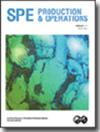A Mathematical Model for Estimating Fracture Permeability with Invasion Damage of Formation Sand
IF 1.3
4区 工程技术
Q2 ENGINEERING, PETROLEUM
引用次数: 0
Abstract
Fracture packing is a well-known completion technique used in the hydraulic fracturing of low-permeability reservoirs. As much as fracture packs are very effective, the proppant-pack permeability damage formed from particle intrusion reduces that effectiveness because it causes low well productivity. It is important to address the issue of permeability damage caused by formation-particle intrusion. An analytical model was developed in this study to predict the permeability of proppant packs in hydraulic fractures with consideration of different levels of invasion damage of formation sand. The accuracy of the model was verified by model comparison with data from the Eagle Ford Shale field. The model result shows that for the Eagle Ford field and the corresponding proppant size used, three blocking levels were achieved that correspond to high proppant-pack permeability. Three case studies were considered in this study: California sand, Gulf Coast sand, and South China Sea silt. The proppant-pack permeability damage was calculated using the analytical model for three levels of invasion for all case studies. The results from applying the analytical model on the three case studies showed the amount of invasion that is possible in each sand according to the proppant size used. The level of invasion is a factor of the sand distribution and the initial proppant size chosen. More analysis showed that for two of the case studies, only Levels 1 and 2 blockings can develop, while for the last case study, three blocking levels considered can develop. This study, for the first time, gives an insight into how selecting the optimal proppant size can improve sand-control performance while enhancing fracture conductivity.考虑地层砂侵入损伤的裂缝渗透率数学模型
裂缝充填是低渗透油藏水力压裂中一种著名的完井技术。尽管压裂充填非常有效,但颗粒侵入形成的支撑剂充填渗透率损害会降低这种有效性,因为它会导致油井生产率低。解决地层颗粒侵入引起的渗透率损害问题具有重要意义。本研究建立了一个分析模型,以预测水力裂缝中支撑剂包的渗透率,同时考虑地层砂的不同侵入损伤程度。通过与Eagle Ford页岩油田的数据进行模型比较,验证了模型的准确性。模型结果表明,对于Eagle Ford油田和使用的相应支撑剂尺寸,实现了三个对应于高支撑剂充填渗透率的堵塞水平。本研究考虑了三个案例研究:加利福尼亚砂、墨西哥湾沿岸砂和南中国海淤泥。在所有案例研究中,使用三个侵入水平的分析模型计算支撑剂充填渗透率损害。将分析模型应用于三个案例研究的结果显示,根据使用的支撑剂尺寸,每种砂中可能存在的侵入量。侵入程度是沙子分布和所选择的初始支撑剂尺寸的一个因素。更多的分析表明,对于其中两个案例研究,只有1级和2级阻断可以发展,而对于最后一个案例研究来说,考虑的三个阻断水平可以发展。这项研究首次深入了解了选择最佳支撑剂尺寸如何在提高裂缝导流能力的同时提高防砂性能。
本文章由计算机程序翻译,如有差异,请以英文原文为准。
求助全文
约1分钟内获得全文
求助全文
来源期刊

Spe Production & Operations
工程技术-工程:石油
CiteScore
3.70
自引率
8.30%
发文量
54
审稿时长
3 months
期刊介绍:
SPE Production & Operations includes papers on production operations, artificial lift, downhole equipment, formation damage control, multiphase flow, workovers, stimulation, facility design and operations, water treatment, project management, construction methods and equipment, and related PFC systems and emerging technologies.
 求助内容:
求助内容: 应助结果提醒方式:
应助结果提醒方式:


